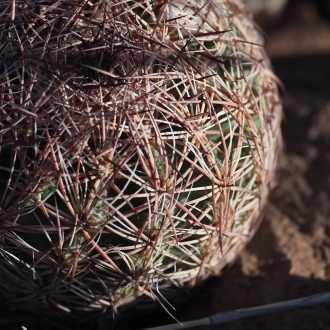These cacti are short, elongated globular, and almost completely covered by spines. Areoles are each on distinctive tubercles that are arranged in rows. They bloom from February to mid-March, opening shortly afternoon and remaining open until dusk. They re-open each day for the next 3–4 days. There are often extrafloral nectaries, but they are hidden by the plant’s spines.
Woven-Spine Cactus (Echinomastus intertextus)
This cactus is variable in almost every aspect of its life. Usually the spines do not completely obscure the stem, but not always. The dozen or more radial spines are closely appressed, forming a flat disc. There is usually but 1 central spine, porrect, slightly downward pointing and much shorter than the radials.

Flowers are mostly white with cream-colored anthers. Style are red. This is the only Pineapple Cactus with red style.

Warnock’s Cactus (Echinomastus warnockii)
This is the most common Echinomastus cactus in the Big Bend area. Usually less than 3 inches tall, it can grow to 8 inches in some places along the river. The 11–15 radial spines grow in divergent directions unlike the flat disc-like growth of the Woven-Spine Cactus. Adults produce one central spine, porrect or an upward pointing spine.
Tan to straw-colored radial spines are gray at the base and chalky blue at the tips or on the entire spine. Central spines are the same color as the radials but blue-gray for half of their length.
Flowers are similar to others in the genus. They are white with bright yellow anthers. Style and stigma lobes are green. This combination of flower colors is diagnostic.

Fruits are light green and remain on the plant after ripening.
Mariposa Cactus (Echinomastus mariposensis)
The Mariposa Cactus grows around Lajitas and in the eastern part of the national park. Though listed as threatened, it is widespread and abundant in its range. It does well on thin Boquillas limestone and on rocky stable substrates.
Mariposa Cactus grows from golf ball to tennis ball size. Its areoles produce 25–32 overlapping ashy white radial spines. Commonly, 4 central spines, heavier than the radial spines, grow – 3 face down and 1 faces up. Typically their tips are darker than the rest of the spine. If the color covers the base of spines the plant doesn’t look so white.

Photo by Joe Sirotnak




FANTASTIC series on the cacti of Big Bend!!! Barton Warnock is singing your praises on high. When is the guidebook going to be published?
Well, as you know, there are no crystal ball repairmen in South Co.,so I don’t really know. But I can tell you that I will finish the draft on the last cactus, Peniocereus gregii today. Next, a bit of noodling on the prickly pears, and the draft will be done! Perhaps I should send you a prepress copy?